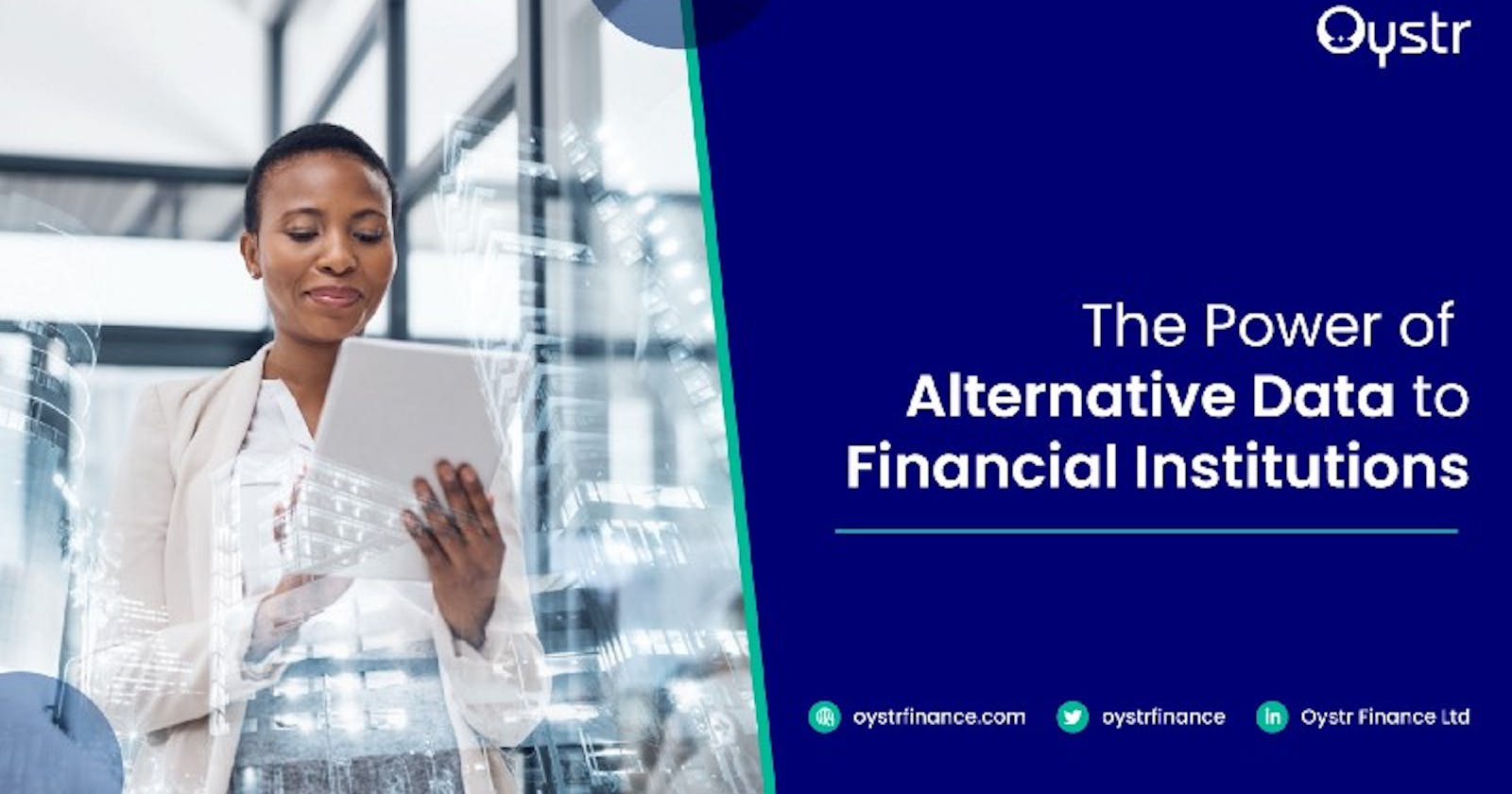The entire world constantly cycles through data-generating elements (people and operations). The increasing population upswings the amount of data yielded in day-to-day activities. More so, the importance of these datasets increased with the advancement of civilization and the adoption of tech innovations.
The Power of Alternative Data to Financial Institutions
Mobile device data, web traffic, app usage, credit card transaction data, social media engagement, product reviews, geolocation data, satellite imagery, weather information, and ESG data have become important parts of everyday life. These alternative data sets give insight into decisions that individuals, governments, and businesses make and how they can affect other decisions.
In Finance, well-informed decisions based on available data tend to produce better strategic results than emotional ones. Financial institutions need to make these decisions every day; hence, they require a lot of data. The conventional sources such as stock offerings, financial records, and published reports might not be enough to adequately inform the present-day decision-making of financial institutions.
As a result, other unconventional data sources capable of providing insights required for decision-making join the train to advise financial institutions. This includes several volumes of data generated from the day-to-day activities of individuals, businesses, industries, and governments. These sets of information that differ from the traditional data sources in finance form the term; alternative data.
What Does Alternative Data Mean to Financial Institutions?
Recently, increasing numbers of financial institutions employ non-traditional data sources that have never been analyzed. These new and unique data sets are called alternative data. Alternative data is readily available and accessible in digitized form but different and unrelated to conventional financial data.
It is derived from unconventional sources, from bank account cash flow analysis and credit card usage patterns to non-banking financial facts such as rent, payday loans, utility bills, etc. Public records such as online and social media activities, educational background, employment status, and asset ownership also serve as sources of alternative data.
Leveraging alternative data allows banks to make educated decisions and helps the financially underserved join the mainstream financial system. In addition, alternative data benefits financial institutions and their clients to great extents. Among other advantages, it mitigates risks for financial institutions.
It also helps consumers with credit eligibility based on profound analysis and understanding of their repayment history on alternative financial services. This kind of data traditionally would not have been deemed considerable in times past. Basically, using alternative data is a smart strategy for financial institutions to generate alpha.
Who Uses Alternative Data?
Alternative data provides market and consumer intelligence to financial institutions. The financial services industry is the vanguard of alternative data usage. In the finance sector, financial institutions act as asset managers, financial advisers, and financial intermediaries. Banks (including digital and neo banks), credit unions, savings and loans associations, investment companies, brokerage companies, insurance companies, and mortgage companies constitute major financial institutions.

Who uses alternative data?
Asset Managers
Asset managers apply quantitative or fundamental research approaches in alternative data usage. A quantitative research strategy involves the application of data science, machine learning, and AI technologies to analyze data into action points.
Hence, quantitative portfolio managers, researchers, and data managers find extracting insights from alternative data easier and quicker by incorporating the data sets into their existing systems.
On the other hand, fundamental research strategies have limited data science technologies. As a result, they are incapable of integrating alternative data sets into their existing systems because their traditional systems and data science knowledge are limited. However, they possess a greater opening to adopt new technologies that enable them to employ alternative data in uncovering insights that grant them a market advantage.
Combining traditional research methods with data science and analytics creates a medley of the two approaches to form an absolute strategy for alternative data usage.
Financial Advisors
Financial institutions that serve as financial advisors employ alternative data to improve their services to their clients by giving them more personalized advice and suggestions. Accessing accurate real-time forecasting and budgeting data that can be incorporated into financial plans boosts a financial advisor’s work and benefits their clients.
Other financial institutions like fintech, Buy now pay now companies, among others
How Much Can Alternative Data Do?
The power of alternative data stretches beyond the bands of datasets to the entire program. It consists of other segments that complete the extraction of insights for financial institutions to make profitable decisions. An effective alternative data program can ingest raw data sources of any size, volume, or structure continuously. These data sets could be unstructured, structured, semi-structured, large quantities of large, or small data files.

How Much Can Alternative Data Do?
Besides the ability to ingest large amounts of data, a complete alternative data program should be able to do all the following:
- Allow discovery and idea testing on ingested data so that use cases can be created and refined based on a subset of given data.
- Prepare newly ingested data to be applicable in all established use cases and promptly deploy new use cases
- Revise a visualization layer that allows analysis and real-time tracking of practical cases.
Application of Alternative Data in Financial Institutions
Here’s how financial institutions can apply alternative data and leverage it for growth.
Forecasting and Predictive Analysis
Making educated guesses about financial trends is a big part of what financial institutions do. This includes demand forecasting, sales prediction, etc, in various categories. Alternative data help them consider different variables that influence their customers and institution. These variables include product supply, consumer demand, and economic trends. Financial analysts can develop demand forecasting models using alternative data such as foot traffic, transaction data, and POI data in areas with similar geography or comparable points in time.
For instance, an investment company uses alternative data to anticipate future trends in consumer demand for certain products or services. This knowledge can be used to predict how particular investments will perform. Alternative data such as foot traffic and transaction data reveal customer interaction with brands and stores hence, serve as insights for predicting the performance of certain investments. Thus, the investment company extracts these data sets to enrich available traditional data, build a predictive model for sales and advise investment decisions.
Customer Experience and Brand Analysis
Alternative data demonstrates its valuable resource for enriching corporate customer relationship management. Financial institutions, including banks and insurance companies, possess a brand reputation.
Therefore, analyzing the public perception of their branches or overall brand is invaluable. Brand monitoring helps financial institutions exceed customer expectations, expand the client base, earn market share, gain competitive advantage, and adapt their services/products to serve the unexpressed needs of clients.
Alternative data such as online reviews and social media engagement most efficiently reveal customer needs, experience, and expectations. This, in turn, helps financial institutions solve critical issues and focus on their strengths.
For instance, a bank collects and monitors real-time conversations and user reviews on its branches and biggest competitors. The semantic analysis of online reviews and comments reveals their customers’ major pain points in their competitors’ service emanate from poor telephone assistance. The bank, therefore, decides to focus on its strength, which is excellent telephone support. Additionally, they highlight it in all their marketing and communication strategies.
Credit Scoring
FiDaaS leverages alternative data, data science, and machine learning with mobile phone and broadband access. This helps mobile operators to create customer insights such as personal credit scores and provide financial institutions with essential information. It also helps financial institutions such as credit unions personalize credit options according to the data available.

Application of Alternative Data in Financial Institutions
Alternative data provides prompt indicators of a client’s credit behavior and condition, individual or corporate. Using alternative data from employment status changes on social media, financial institutions assess the direction of personal or corporate finance trends.
Such information can help analyze consumers’ credit scores as a function of financial behavior, challenges, or income-earning. In addition, it reveals the risk posed by giving them credit beyond the scores.
For instance, a special data algorithm enables financial managers to review a company or individual by finding commercial activities and businesses linked to its VAT number. VAT matching is one of the uprising applications of alternative Data in the financial industry.
It is simply the validation of parity between a company and VAT (tax ID) numbers. The power of this compact data reveals a total, precise image of a company’s financial situation in assessing a commercial loan or mortgage request.
Market Signal and Event Tracking
A myriad of events such as terrorist attacks, natural disasters, economic downturns, and disease outbreaks influence financial climates such as various industries, stock markets, etc., to significant degrees. Alternative data helps financial institutions track such macroeconomic events and empowers them to take quick, proactive steps.
Alternative data also provides and tracks market signals that advise financial institutions and clients. For instance, broadcast transcripts of interviews contain potential insights into a company’s strategic decision-making rationale.
Data Modeling and Historical Analysis
Alternative data helps financial institutions identify consequential patterns that affect them and their clients. The ability to feed new datasets into existing algorithms and analytics helps cover the gaps left due to previously unavailable information.
Banks and other financial institutions use large historical data to evaluate past performance and accurately predict future potential. Alternative data provides comprehension and prediction of responses to opportunities and risks by analyzing historical data obtained from various sources.
In addition, the historical analysis serves as a very powerful and timely oracle of potential crises and critical issues. Alternative data can predict financial performance in a new market based on modeling done in a previous market. This provides key insights on decreasing performance trends that might be warning signs of potential financial issues in the future. The combination of alternative data with real-time information makes this effective.
For instance, a small diner group with five branches applied for a bank loan. The bank evaluates its financial statements and reputation and finds unsettling information. Between January 2020 and February 2021, data portraying low guest turnouts, income, and revenues appeared. But, historical analysis of alternative data from 2017 revealed that the diner had a robust performance with thousands of invariably positive reviews and online feedback. The analysis suggests that the diner’s performance was affected by the pandemic. This enabled the bank to assess the diner’s loan request based on historical and real-time data.
Idea Testing, Opportunity Sourcing, and Risk Assessment
Alternative data provides data sets that make risk assessment more thorough and help avoid and manage bad risks. Moreover, it helps financial institutions strategically evaluate new deals and opportunities through client/customer profiling, exclusive insights, and KPIs.
Alternative data optimizes the profiling of potential clients and partners and provides datasets that easily point out market interests in a particular territory. Using these profiles, they test and evaluate the potential of an idea or opportunity.
For instance, financial institutions leverage alternative data from online channels and social networks to enrich their clients’ profiles with detailed, qualitative insights, such as a company’s sentiment score, to encourage investment.
Financial Inclusion
Alternative data plays a key role in the journey towards an inclusive economy. Certain information is essentially inaccessible to financial institutions due to a lack of financial access. Alternative data makes this information on unbanked individuals available to financial institutions. This provides financial institutions with the information required to extend their financial services and products to the unbanked. As a result, they serve underserved populations better and promote financial inclusion in the same vein.
For instance, an unbanked medium-scale business operates completely with cash, without a financial identity. However, on hearing of how insurance companies help businesses cope with crises, the business owner desires to access the service. Without any financial information based on previous transactions, the insurance company might need to tap into alternative datasets. Therefore, they gain necessary insights and additional information on the business.
Final Note
Alternative data is essential to financial institutions in no small way. Reliable and accurate alternative data need to be fed into their models and analytics to inform their decision-making process. Traditional data sources barely provide enough information for competitive advantage in any industry. Alternative data bridges this gap and provides real-time and historical information to inform financial institutions in taking calculated steps.
However, failure to harness reliable insights from alternative data can lead decision-making astray. It results in huge, unprecedented losses for them and their clients. Hence, the power of alternative data to financial institutions cannot be overemphasized.
Thinking of where to access such powerful alternative data? Oystr is a grand alternative data infrastructure, helping financial institutions make accurate decisions, increase customer base and yield financial inclusion. Visit us to find out more.

